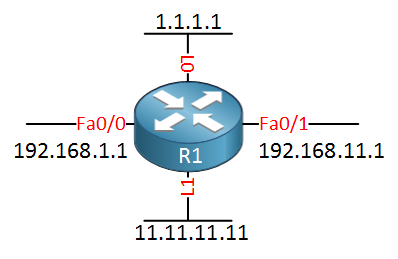Each OSPF router selects a router ID (RID) that has to be unique on your network. OSPF stores the topology of the network in its LSDB (Link State Database), and each router is identified with its unique router ID. If you have duplicate router IDs, then you will run into reachability issues.
Because of this, two OSPF routers with the same router ID will not become neighbors, but you could still have duplicated router IDs in the network with routers that are not directly connected. If you don’t manually configure a router ID, OSPF will select one on its own and use the following criteria to select the router ID:
- Manual configuration of the router ID.
- The highest IP address on a loopback interface.
- The highest IP address on a non-loopback interface.
Let’s see this in action. I will use the following router for this demonstration:

There are two physical interfaces and two loopback interfaces. All interfaces are active:
R1#show ip interface brief
Interface IP-Address OK? Method Status Protocol
FastEthernet0/0 192.168.1.1 YES manual up up
FastEthernet0/1 192.168.11.1 YES manual up up
Loopback0 1.1.1.1 YES manual up up
Loopback1 11.11.11.11 YES manual up upLet’s start an OSPF process:
R1(config)#router ospf 1
R1(config-router)#exitNow we can check what router ID it selected:
R1#show ip protocols | include Router ID
Router ID 11.11.11.11It selected 11.11.11.11 which is the highest IP address on our loopback interfaces. Let’s get rid of the loopbacks now:
R1(config)#no interface loopback 0
R1(config)#no interface loopback 1Take a look again at the router ID:
R1#show ip protocols | include Router ID
Router ID 11.11.11.11It’s still the same, this is because the router ID selection is only done once. You have to reset the OSPF process before it will select another one:
R1#clear ip ospf process
Reset ALL OSPF processes? [no]: yesLet’s see if this makes any difference:
R1#show ip protocols | include Router ID
Router ID 192.168.11.1There we go, the router ID is now the highest IP address of our physical interfaces. If you want we can manually set the router ID. This will overrule everything:



Good Stuff.
Thanks for streamline it.
Renee
Hope you are well - can you tell me please if I configure a router ID on my router in OSPF which i just did on one of the GNS3 Vault Labs … do I also have to specify that router ID or configure it also as a Loopback interface ? Anyway I just configured the router ID and it was preferred to the existing L0 address which I expected but not sure if it also needs to have its own address space on the router elsewhere ?
Thanks
Will
Sorry forgot to tick the ‘please email me of notification’
Renee
Just wondering if you saw my post please as stuck on this issue ?
Rgds
Will